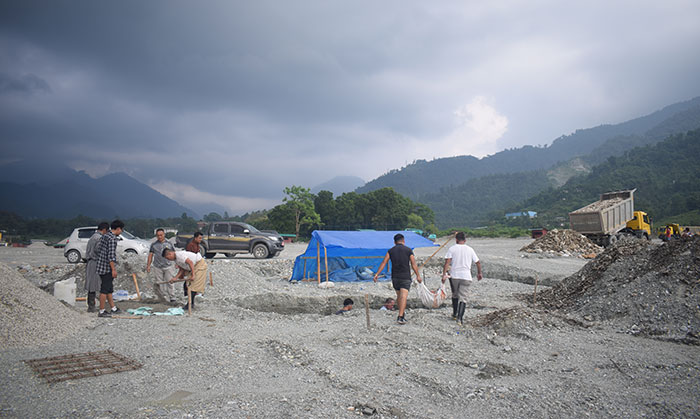Rajesh Rai | Samtse
Export of boulders (and aggregates) to Bangladesh and India from Samtse is expected to resume this week, according to dredging companies and exporters.
A dry port has been developed at Sukhreti for this purpose in Samtse.
A 61-acre land has been identified and 29 dredging and mining companies have been allotted the plots to stock their materials.
This dry port is located adjacent to the border gate and serves strategically in terms of Covid-19 safety protocols. Vehicles will not have to enter into the town beyond the gate.
The dzongkhag engineer, Kinzang Dorji said that the dry port was developed on a 60:40 expenditure ratio between the private parties and the government.
“On the government part, we have constructed an office structure for the relevant law enforcement agencies,” he said.
The engineer also said that the land was leased to the private parties and they will not have to pay lease rent for six months, until December this year.
It has been decided that Indian trucks and Indian drivers will be engaged for the export purpose. All safety protocols and procedures will be followed.
Later, should the situation improve, Bhutanese vehicles will be used with Indian drivers with the trucks kept outside. On the third stage, should there be more improvement, Bhutanese trucks and Bhutanese drivers will be engaged in this export.
The private companies have constructed two infrastructures each, one that will be used as a containment area for Indian drivers and the other for Bhutanese operators. The entire port area will function as a containment area. Limited number of staffs will be allowed.
At the dry port yesterday, dzongkhag engineer Kinzang Dorji and technicians were busy with the construction of observation towers. Three such towers will be constructed.
Kinzang said they had to work on the construction themselves because labourers were not available these days.
It has been almost a month since the dry port development started. However, dredging companies have already started to bring in their stocks at the port and are ready to export.
An official with BMML, a dredging company in Samtse, Sangay Tenzin, said that all dredging companies and boulder exporters were strained financially without the export for more than three months. Although there are stocks, without the export, companies and exporters have been idle.
“That’s why this dry port was developed. And now we are going to export,” he said.
Sangay Tenzin said that most of the companies had completed construction of infrastructure at the dry port and were just waiting for the export to start.
“Indian market and the Bangladesh market are ready to take the materials.”
Before the export, it was necessary that every necessary safety and security measures had to be put in place.
“In another two or three days, we will be able to export.”
The export will be on trial basis and the number of vehicles will be limited, it has been learned. The export will be expanded eventually depending on the situation. This month, exporters will concentrate more on the export stablility and issues so that they would resolve in the coming months and look into increasing the export.
The general manager with another dredging company, SKD Construction Private Limited, Chundu Tshering, said that they have completed construction of the containment infrastructures at the port.
He said the export will help the country boost its export figures, which has been hit the hardest due to the pandemic.
“Also, we just have expenditure at the moment,” he said, adding the resuming the export will help both the government, dredging companies and exporters.
Boulder was the second most exported Bhutanese product in 2019, after ferrosilicon.
The total export of boulder last year doubled to Nu 4.9B from Nu 2.1B in 2018. In 2017, boulder export value stood at Nu 690 million (M), seventh among the top ten export commodities.
Export value of pebbles, gravel, broken or crushed stone increased to a whopping Nu 1.8B and became the third most exported commodities. In 2018, Bhutan recorded an export value of Nu 895M.


